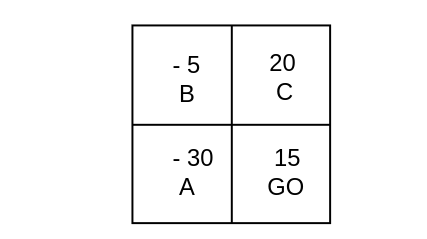exercise:Cdfad49bfa: Difference between revisions
From Stochiki
(Created page with "<div class="d-none"><math> \newcommand{\NA}{{\rm NA}} \newcommand{\mat}[1]{{\bf#1}} \newcommand{\exref}[1]{\ref{##1}} \newcommand{\secstoprocess}{\all} \newcommand{\NA}{{\rm NA}} \newcommand{\mathds}{\mathbb}</math></div> A highly simplified game of “Monopoly” is played on a board with four squares as shown in Figure \ref{fig 11.7}. You start at GO. You roll a die and move clockwise around the board a number of squares equal to the number that turns up on the...") |
No edit summary |
||
| Line 5: | Line 5: | ||
\newcommand{\secstoprocess}{\all} | \newcommand{\secstoprocess}{\all} | ||
\newcommand{\NA}{{\rm NA}} | \newcommand{\NA}{{\rm NA}} | ||
\newcommand{\mathds}{\mathbb}</math></div> A highly simplified game of “Monopoly” is played on a | \newcommand{\mathds}{\mathbb}</math></div> A highly simplified game of “Monopoly” is played on a board with four squares as shown in [[#fig 11.7|Figure]]. You start at GO. You roll a die and move clockwise around the board a number of squares equal to the number that turns up on the die. You collect or pay an amount indicated on the square on which you land. You then roll the die again | ||
board with four squares as shown in | |||
You start at GO. You roll a die and move clockwise around the board a number | |||
of squares equal to the number that turns up on the die. You collect or pay an | |||
amount indicated on the square on which you land. You then roll the die again | |||
and move around the board in the same manner from your last position. Using the | and move around the board in the same manner from your last position. Using the | ||
result of | result of [[exercise:60b4d769a6 |Exercise]], estimate the amount you should expect to win in the long run playing this version of Monopoly. | ||
the long run | |||
playing this version of Monopoly. | |||
<div id="PSfig11-7" class="d-flex justify-content-center"> | <div id="PSfig11-7" class="d-flex justify-content-center"> | ||
[[File:guide_e6d15_PSfig11-7. | [[File:guide_e6d15_PSfig11-7.png | 400px| thumb|Simplified Monopoly ]] | ||
</div> | </div> | ||
Latest revision as of 02:35, 15 June 2024
[math]
\newcommand{\NA}{{\rm NA}}
\newcommand{\mat}[1]{{\bf#1}}
\newcommand{\exref}[1]{\ref{##1}}
\newcommand{\secstoprocess}{\all}
\newcommand{\NA}{{\rm NA}}
\newcommand{\mathds}{\mathbb}[/math]
A highly simplified game of “Monopoly” is played on a board with four squares as shown in Figure. You start at GO. You roll a die and move clockwise around the board a number of squares equal to the number that turns up on the die. You collect or pay an amount indicated on the square on which you land. You then roll the die again
and move around the board in the same manner from your last position. Using the result of Exercise, estimate the amount you should expect to win in the long run playing this version of Monopoly.
